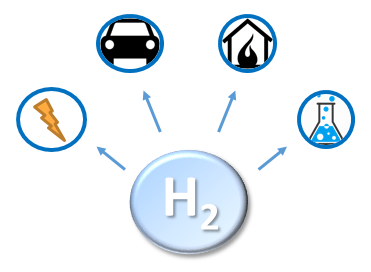Hydrogen is the lightest element of the periodic table and it therefore requires to be stored as a highly pressurised gas or liquid to prevent any leaks to the atmosphere. It is the most common element in the universe, which makes it an attractive alternative to other non-renewable energy sources. Hydrogen naturally appears only as a combination with other elements, and therefore chemical reaction is required to separate it from the other elements. Currently the majority of hydrogen used comes from the reformation of fossil fuels. [1] However there are other proven clean techniques that are capable of tackling this challenge. One of these techniques is electrolysis.
Separated hydrogen is the main core of the hydrogen economy concept that has been a major area of scientific interest for decades. This is mainly due to the fact that stored hydrogen can be used not only to meet electrical, heating and transport demands but also to produce various chemicals, including fertilisers, which are vastly used in the agriculture industry. Figure 1 gives an overview of the possible uses for Hydrogen. Most of these sectors are currently highly dependent on the use of fossil fuels, thus hydrogen economy has a notable potential of reducing the greenhouse gas emissions, while moving towards more sustainable future.
Separated hydrogen is the main core of the hydrogen economy concept that has been a major area of scientific interest for decades. This is mainly due to the fact that stored hydrogen can be used not only to meet electrical, heating and transport demands but also to produce various chemicals, including fertilisers, which are vastly used in the agriculture industry. Figure 1 gives an overview of the possible uses for Hydrogen. Most of these sectors are currently highly dependent on the use of fossil fuels, thus hydrogen economy has a notable potential of reducing the greenhouse gas emissions, while moving towards more sustainable future.
Regardless of the energy sector, hydrogen must be separated from other chemical compounds before being stored in a storage tank. This can be done in various ways, electrolysis being one of the clean options, assuming that consumed electricity comes from renewable sources. The system uses electricity to electrolyse water, which is required to separate hydrogen from oxygen. The only side product of the process is water, meaning the cycle is carbon free with no harmful emissions. The input of the process is water, which is an abundant source in many parts of the world, including the UK. This process is shown graphically in Figure 2.
The electricity sector in the UK has been experiencing major changes in the past years that are strongly related to low-carbon transition targets. Due to intermittency of renewable energy sources, the need for an adequate storage system is unarguable. Therefore, hydrogen based systems could play a vital role alongside other technologies. Stored hydrogen can generate electricity when processed through a fuel cell, or alternatively hydrogen can be directly burnt to power a gas turbine. Even though there are advantages and drawbacks of each solutions, the first mentioned technology has been chosen for this project. This is mainly due to the fact that burning hydrogen in the atmosphere still produces dangerous emissions that could negatively contribute to climate change issues.
While renewable power generation has been rapidly increasing in the past years, clean transport has not been widely implemented yet. Hydrogen economy concept could provide a clean alternative to current fossil fuel usage. Regarding the car industry, Fuel Cell Vehicles (FCV) are already available on the market and can be occasionally seen in the UK. Moreover, hydrogen buses and ferries could replace traditional transportation means in the future, while being a key player in comparison to other clean technologies due to its wide miles of range. [2]
The heating sector in the UK is heavily dependent on natural gas usage. The current and future heating demand could be met by hydrogen based systems, as the vast majority of losses from all main stages, including electrolyser, compressor and fuel cell, are dissipated as heat. These losses could be turned into an advantage if adequate controls are applied. Alternatively, hydrogen could be combined with carbon dioxide to produce methane (methane reformation) for direct use in heating and cooking applications, known as Power-to-Gas. This gas can be pumped directly into the pipeline, thus no extra infrastructure is needed. Pilot plant examples of Power-to-Gas exist in Germany currently. [2] Potentially, hydrogen could also be burnt directly, however hydrogen burns hotter than methane and so appliances would have to be calibrated for hotter temperatures and there are risks of NOx production within the home. Additionally, current laws only allow low percentages of hydrogen in the pipelines. However, experimental schemes putting up to 15% hydrogen into the pipelines are being implemented in the Netherlands. [3] Finally, heating could be provided by electrical heaters that consume electricity generated from fuel cells, however this solution is fairly inefficient compared to the other methods mentioned above. [4]
Altogether, hydrogen is a flexible energy vector and a crucial feed stock to a variety of chemical industries, where one of the main products is ammonia made through methane reformation from fossil fuels. Green hydrogen systems can therefore replace this unsustainable method and produce ammonia, which is the starting chemical of most fertilisers, with zero carbon emissions. Since fertiliser producers already have infrastructure in the place, hydrogen can be directly sold to their factories to finish the process where hydrogen is combined with nitrogen to create ammonia.
Many projects are trying to implement the idea of a hydrogen economy, but on a smaller scale. One of the real examples is the Bright Green Hydrogen office in Methil that uses renewable energy generation, electrolyser, hydrogen storage and to supply hydrogen to their own fleet of numerous Fuel Cell Vehicles. These real installations have proven the applicability of hydrogen economy in practice on a small scale. Therefore, SEnS intends to study larger-scale applications, and investigate whether hydrogen storage system can contribute towards decarbonisation of electrical and transport sector in the UK.
While renewable power generation has been rapidly increasing in the past years, clean transport has not been widely implemented yet. Hydrogen economy concept could provide a clean alternative to current fossil fuel usage. Regarding the car industry, Fuel Cell Vehicles (FCV) are already available on the market and can be occasionally seen in the UK. Moreover, hydrogen buses and ferries could replace traditional transportation means in the future, while being a key player in comparison to other clean technologies due to its wide miles of range. [2]
The heating sector in the UK is heavily dependent on natural gas usage. The current and future heating demand could be met by hydrogen based systems, as the vast majority of losses from all main stages, including electrolyser, compressor and fuel cell, are dissipated as heat. These losses could be turned into an advantage if adequate controls are applied. Alternatively, hydrogen could be combined with carbon dioxide to produce methane (methane reformation) for direct use in heating and cooking applications, known as Power-to-Gas. This gas can be pumped directly into the pipeline, thus no extra infrastructure is needed. Pilot plant examples of Power-to-Gas exist in Germany currently. [2] Potentially, hydrogen could also be burnt directly, however hydrogen burns hotter than methane and so appliances would have to be calibrated for hotter temperatures and there are risks of NOx production within the home. Additionally, current laws only allow low percentages of hydrogen in the pipelines. However, experimental schemes putting up to 15% hydrogen into the pipelines are being implemented in the Netherlands. [3] Finally, heating could be provided by electrical heaters that consume electricity generated from fuel cells, however this solution is fairly inefficient compared to the other methods mentioned above. [4]
Altogether, hydrogen is a flexible energy vector and a crucial feed stock to a variety of chemical industries, where one of the main products is ammonia made through methane reformation from fossil fuels. Green hydrogen systems can therefore replace this unsustainable method and produce ammonia, which is the starting chemical of most fertilisers, with zero carbon emissions. Since fertiliser producers already have infrastructure in the place, hydrogen can be directly sold to their factories to finish the process where hydrogen is combined with nitrogen to create ammonia.
Many projects are trying to implement the idea of a hydrogen economy, but on a smaller scale. One of the real examples is the Bright Green Hydrogen office in Methil that uses renewable energy generation, electrolyser, hydrogen storage and to supply hydrogen to their own fleet of numerous Fuel Cell Vehicles. These real installations have proven the applicability of hydrogen economy in practice on a small scale. Therefore, SEnS intends to study larger-scale applications, and investigate whether hydrogen storage system can contribute towards decarbonisation of electrical and transport sector in the UK.
[1] S. Banerjee, M. N. Musa, A. B. Jaafar. Economic assessment and prospect of hydrogen generated by OTEC as future fuel. International Journal of Hydrogen Energy, Volume 42, Issue 1, January 2017, pp. 26–37.
[2] http://www.itm-power.com/project/thuga-power-to-gas
[3] P.E. Dodds, W. McDowall, The future of the UK gas network, Energy Policy, Volume 60, 2013, pp. 305–316.
[4] W. McDowall, M. Eames. Towards a sustainable hydrogen economy: A multi-criteria sustainability appraisal of competing hydrogen futures. International Journal of Hydrogen Energy, Volume 32, Issue 18, December 2007, pp. 4611–4626.
[2] http://www.itm-power.com/project/thuga-power-to-gas
[3] P.E. Dodds, W. McDowall, The future of the UK gas network, Energy Policy, Volume 60, 2013, pp. 305–316.
[4] W. McDowall, M. Eames. Towards a sustainable hydrogen economy: A multi-criteria sustainability appraisal of competing hydrogen futures. International Journal of Hydrogen Energy, Volume 32, Issue 18, December 2007, pp. 4611–4626.



